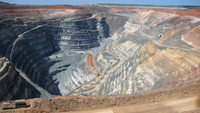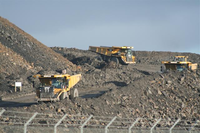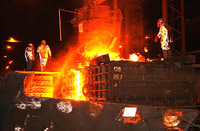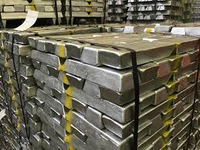Difference between revisions of "Extraction of Metals"
| Line 6: | Line 6: | ||
There are 3 main ways '''extraction of metals''' takes place: | There are 3 main ways '''extraction of metals''' takes place: | ||
*None - [[Element]]s below [[Hydrogen]] are found [[Native]] which means the [[metal]] [[element]] can be found not as part of a [[compound]]. | *None - [[Element]]s below [[Hydrogen]] are found [[Native]] which means the [[metal]] [[element]] can be found not as part of a [[compound]]. | ||
| − | *[[Smelting]] - [[Element]]s above [[Hydrogen]] but below [[Carbon]] are found in [[metal]] [[compound]]s so they need to be [[Extraction of Metals|extracted]] by using [[Carbon]] to [[Displacement Reaction|displace]] the [[metal]] from the [[compound]]. | + | *[[Smelting]] - [[Element]]s above [[Hydrogen]] but below [[Carbon]] are found in [[mineral]]s, which are [[metal]] [[compound]]s so they need to be [[Extraction of Metals|extracted]] by using [[Carbon]] to [[Displacement Reaction|displace]] the [[metal]] from the [[compound]]. |
| − | *[[Electrolysis]] - [[Element]]s above [[Carbon]] are found in [[ | + | *[[Electrolysis]] - [[Element]]s above [[Carbon]] are found in [[mineral]]s but they cannot be [[Extraction of Metals|extracted]] with [[Carbon]] because [[Carbon]] is less [[Reactivity|reactive]] than those [[metal]]s so we use [[electrolysis]] to [[Extraction of Metals|extract]] them. |
{| class="wikitable" | {| class="wikitable" | ||
Revision as of 16:16, 1 October 2018
Contents
Key Stage 3
Meaning
Extraction of Metals is how we get usable metal from ore found in the ground.
About Extraction of Metals
There are 3 main ways extraction of metals takes place:
- None - Elements below Hydrogen are found Native which means the metal element can be found not as part of a compound.
- Smelting - Elements above Hydrogen but below Carbon are found in minerals, which are metal compounds so they need to be extracted by using Carbon to displace the metal from the compound.
- Electrolysis - Elements above Carbon are found in minerals but they cannot be extracted with Carbon because Carbon is less reactive than those metals so we use electrolysis to extract them.
| The ores are mined from the ground using explosives and heavy machinery. | The ores are transported to metal refineries by trucks, trains and boats. The metal refineries can be thousands of miles away. | The material is purified to remove unwanted pieces of rock. If the metal is native it is put in a furnace to melt. If the metal is in a compound it is either put in a furnace with Carbon to displace it or it is placed in an electrolysis cell to be extracted with electricity. | The metal is then molded into ingots before being transported again to where they are needed. |
Environmental Concerns
- All stages of the extraction process can cause damage to the environment and concerns are raised about the local impact and global impact of extraction.
Local Concerns
- A large area of land is destroyed to make space for a quarry. This can be habitats for local organisms.
- Local people complain of increased traffic.
- Explosives are often used in mining which can disturb local people and wildlife.
- People who live near metal refineries can be affected by the pollution given off by the refinery.
Global Concerns
- Machines used to mine produce Carbon Dioxide which contribute to Global Warming.
- Transporting ore produces Carbon Dioxide which contribute to Global Warming.
- Metal refineries produce Carbon Dioxide as well as other pollution including Sulphur Dioxide and Nitrous Oxides which lead to Acid Rain.



